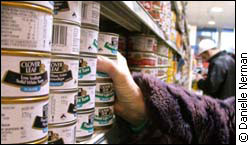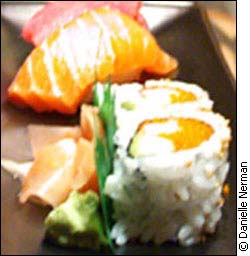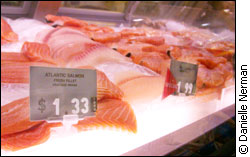| Tuna:
toxic or misunderstood?
By Danielle Nerman
OTTAWA —
When Missy Hecker found out that eating too much tuna
could be potentially harmful to one’s health,
she reacted immediately. “I
took him right off the tuna,” says Hecker, a Toronto
homemaker.
 |
| Hecker worried that her son's
consumption of three to four cans of tuna per week
was starting to affect his behavior. |
Hecker is referring to her seven-year-old
son Max, who for the past two years, had been eating
canned tuna three to four times a week.
Hecker had read somewhere that tuna contains
mercury. Over-exposure to this toxic metal can damage
a child’s developing nervous system and cause
irreversible intellectual impairment.
And since Max had already been diagnosed
with Attention Deficit Hyperactivity Disorder (ADHD),
Hecker was suspicious that her son’s irrational
behaviour was being caused by something else.
“It was like a little light went
on,” says Hecker. “I thought, ‘maybe…just
maybe all the tuna he’s been eating is causing
him to act this way,’” she adds.
Curious to find out, Hecker took Max
to get his blood tested for mercury exposure.
It took five weeks for Hecker to get
the results. During the wait, both Hecker and her husband
noticed a difference in their son’s behaviour.
“Before, he was very hyper…his
mind never stopped. Never, ever, ever,” says Hecker.
“But once I stopped feeding him the tuna, he just…started
acting more normal.”
When Hecker finally got Max’s tests
back, they showed he had elevated levels of mercury
in his blood. And though the levels weren't toxic, they
were four times above normal.
Goodbye sushi?
So, does this mean everyone has to give
up sushi and tuna sandwiches?
 |
| Each year, Canadian sushi
restaurants serve millions of pounds of fresh bluefin
and bigeye tuna to their customers. |
Yes…and no.
Carole Saindon, a media relations officer
at Health Canada, says it is important that people get
their facts straight before they start cutting every
indulgence out of their diets.
“Health Canada has set guidelines
which advise Canadians to limit – not stop –
their consumption of fresh and frozen tuna to one meal
per week,” says Saindon.“And because mercury
can strongly affect fetal and child development, we
recommend that pregnant women and children eat it no
more than once a month.”
Saindon says people also need to realize
that these guidelines are ultra-conservative.
“Recommendations made by Health
Canada are always way below what is considered ‘dangerous,’
” says Saindon. “Otherwise we would ban
it altogether. We would never take the risk of allowing
tuna to be sold in Canada if we thought it could hurt
someone.”
Furthermore, advice given by Health Canada
is based on the potential exposure to mercury that can
occur from eating tuna over a lifetime.
“The amount of mercury in each serving
of tuna is so tiny, that you would have to eat it five
times a week for your entire life to feel the effects,”
says Saindon.
Thee average levels of mercury in fresh
and frozen tuna are typically between 0.5 and 1.5 parts
per million (ppm).
Saindon says this measurement is
incredibly small.
“One part per million is equivalent
to one minute in two years, one bad apple in 2,000 barrels
of apples, and one inch in sixteen miles,” says
Saindon. “So really, you would have to eat an
awful lot of tuna, for a very long period time to get
poisoned.”
So, perhaps that is the reason why Max
– a child who had been eating tuna four times
a week for two years – was more susceptible to
the effects of mercury than other members of the population.
Mercury in nature
However, tuna isn't the only way in which
humans are exposed to mercury. Traces of the toxic metal
can be found on almost every inch of our earth.
Mercury is an element that exists naturally
in the earth’s crust. For billions of years, rocks,
soil and volcanic eruptions have been releasing the
metal into the environment. It exists in three forms:
elemental, inorganic and organic.
Elemental, or pure mercury, is the silvery
liquid found in thermometers.
Inorganic mercury is formed when mercury
combines with non-carbon substances. In the 1800’s,
an inorganic type of mercury, called mercury nitrate,
was used in the felt hat industry. Constant exposure
to the chemical eventually poisoned the hatters and
caused them to act peculiar. This is where the term,
“mad as a hatter” came from.
| 'It's possible
that mercury emitted from a coal plant in Russia
will end up polluting a lake or river in Canada.' |
Human activity only releases elemental
and inorganic mercury into the environment. Typically,
organic mercury is the by-product of elemental and inorganic
mercury entering and reacting with the environment.
Luke Tripp is an environmental consultant
for Specialists in Energy, Nuclear and Environmental
Sciences (SENES) in Ottawa. He says that up until the
Industrial Revolution, Mother Nature released the primary
source of mercury into the earth’s oceans and
atmosphere.
But in the last hundred years, human activity
has greatly increased the amount of mercury in the global
environment. Tripp says every year, coal-fired power
plants, commercial mining and hospital incinerators
worldwide release thousands of tonnes of mercury into
the atmosphere.
“Many scientists worry that we may
actually be reaching critical levels,” says Tripp.
“But, because there's no population on earth that
hasn't been affected by mercury pollution, we have nothing
to measure against.”
Moving through the food chain
To make things even more difficult, mercury
changes from a liquid to a vapour at room temperature.
This enables large amounts of it to bypass industry
smokestack filters.
Mercury vapours can stay airborne anywhere
from 6 to 18 months.
“This gives it a lot of time to
circle the globe,” says Tripp. “It’s
possible that mercury emitted from a coal plant in Russia
will end up polluting a lake or river in Canada.”
Whether or not it was produced locally
or came from another continent, all atmospheric mercury
eventually falls back to earth. Rainfall deposits the
mercury into rivers, lakes and oceans.
 |
| Fresh tuna has higher levels
of mercury than canned because it's caught at a
much bigger size. This means it's had more time
to accumulate mercury through the food chain. |
There, bacteria transform elemental and
inorganic mercury into methyl mercury – an extremely
toxic blend of organic mercury.
Through the process of bioaccumulation,
methyl mercury rapidly builds up in the food chain.
Bioaccumulation begins at the bottom
of the food chain. Plants ingest methyl mercury as they
feed, and pass it on to the small fish that eat them.
However, because these small fish generally
don’t eat just one plant, every time they feed
they end up ingesting three to four times the amount
of mercury that’s in each plant. This process
repeats itself up the food chain; causing mercury levels
to get higher as the fish and animals get bigger.
Fresh vs. canned
"Tuna are big and predatory fish.
They can eat at least a hundred fish a week,”
says Tripp. “So, as you can imagine, one big tuna
can accumulate a lot of mercury.”
However, Tripp is talking about the Bluefin
and Bigeye species of tuna, typically seen in supermarkets
and sushi bars. These fresh and frozen species are not
used in the canned varieties.
Canned tuna is made up of younger and
smaller species, such as Yellowfin, Skipjack and Albacore.
It is for this reason that Health Canada’s
consumption guideline of one meal per month for pregnant
women and children and one meal per week for the rest
of the population does not apply to canned tuna.
“Because the tuna used in canned
is caught so much smaller and younger than fresh and
frozen species, it has less time to accumulate large
amounts of mercury,” says Glenn McGregor, manager
of Product Inspection for the Fish, Seafood and Production
Division of the Canadian Food Inspection Agency (CFIA).
 |
| Health Canada recommends
that Canadians limit their consumption of fresh
and frozen tuna to one meal per week. |
“So most canned tuna contains levels
of mercury that are well below the 0.5 ppm guideline
set by Health Canada for commercial fish,” he
adds.
Fresh and frozen tuna typically contain
levels of mercury that exceed Health Canada’s
guideline level of 0.5 ppm. Applying this guideline
to fresh and frozen tuna would virtually eliminate the
species from the Canadian diet.
As a result, Health Canada does not enforce
the 0.5 ppm guideline level on fresh and frozen tuna.
Instead, they advise Canadians to limit their consumption
of the species to avoid unnecessary exposure to hazardous
levels or mercury.
However, since canned tuna does not fall
under the fresh and frozen consumption guideline, it
continues to be enforced under the 0.5 ppm guideline
level for mercury.
“Every year, CFIA does about 60
to 80 tests on shipments of imported canned tuna,”
says McGregor.
“We randomly pick one in every twenty
shipments and from each shipment, we test 5 to 13 cans,”
he adds.
If a can exceeds the guideline levels
of 0.5 ppm, CFIA will start monitoring the packer’s
shipments. If the problem continues, the packer is put
under import alert. This means anything the packer brings
into Canada will be held in detention until it can be
tested by one of CFIA’s inspectors.
“The packer’s shipments of
canned tuna must pass four inspections before their
name can come off import alert,” says McGregor.
McGregor says overall, Health Canada and
the CFIA are very careful in ensuring that Canadians
are protected from mercury exposure.
The rest is up to Canadians, who need
to read between the lines and use their common sense
before making the decision that eating tuna is a ‘fishy’
business.
|